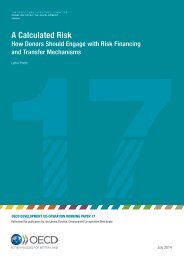UNIVERSITY
Livelihood_resilience_working_paper22
Livelihood_resilience_working_paper22
You also want an ePaper? Increase the reach of your titles
YUMPU automatically turns print PDFs into web optimized ePapers that Google loves.
Early warning system xxix : “The set of capacities needed to generate and disseminate timely and <br />
meaningful warning information to enable individuals, communities, and organizations threatened <br />
by a hazard to prepare to act promptly and appropriately to reduce the possibility of harm or loss” <br />
(Glossary, IPCC WG2 AR5 2014). <br />
Ecosystem: “An ecosystem is a functional unit consisting of living organisms, their non-‐living <br />
environment, and the interactions within and between them. The components included in a given <br />
ecosystem and its spatial boundaries depend on the purpose for which the ecosystem is defined: in <br />
some case they are relatively sharp, while in others they are diffuse. Ecosystem boundaries can <br />
change over time. Ecosystems are nested within other ecosystems, and their scale can range from <br />
very small to the entire biosphere. In the current era, most ecosystems either contain people as key <br />
organisms, or are influenced by the effects of human activities in their environment” (Glossary, IPCC <br />
WG2 AR5 2014). <br />
Environmental migration: “Environmental migration refers to human migration where <br />
environmental risks or environmental change plays a significant role in influencing the migration <br />
decision and destination. Migration may involve distinct categories such as direct, involuntary, and <br />
temporary displacement due to weather-‐related disasters; voluntary relocation as settlements and <br />
economies become less viable; or planned resettlement encouraged by government actions or <br />
incentives. All migration decisions are multi-‐causal, and hence it is not meaningful to describe any <br />
migrant flow as being solely for environmental reasons” (Glossary, IPCC WG2 AR5 2014).’’ <br />
Environmental stressor xxx : An event or trend, related to the natural environment, which has an <br />
important effect on the system exposed and can increase vulnerability to climate-‐related risk <br />
(adapted from Glossary, IPCC WG2 AR5 2014).<br />
Extreme weather event: “An extreme weather event is an event that is rare at a particular place and <br />
time of year. Definitions of rare vary, but an extreme weather event would normally be as rare as or <br />
rarer than the 10th or 90th percentile of a probability density function estimated from observations. <br />
By definition, the characteristics of what is called extreme weather may vary from place to place in <br />
an absolute sense. When a pattern of extreme weather persists for some time, such as a season, it <br />
may be classed as an extreme climate event, especially if it yields an average or total that is itself <br />
extreme (e.g., drought or heavy rainfall over a season)” (Glossary, IPCC WG2 AR5 2014). <br />
Food security xxxi : “A state that prevails when people have secure access to sufficient amounts of safe <br />
and nutritious food for normal growth, development, and an active and healthy life” (Glossary, IPCC <br />
WG2 AR5 2014). <br />
Hazard: “The potential occurrence of a natural or human-‐induced physical event or trend, or <br />
physical impact, that may cause loss of life, injury, or other health impacts, as well as damage and <br />
loss to property, infrastructure, livelihoods, service provision, and environmental resources. In this <br />
report [IPCC WG2 AR5], the term hazard usually refers to climate-‐related physical events or trends <br />
or their physical impacts” (Glossary, IPCC WG2 AR5 2014). <br />
Human security: “A condition that is met when the vital core of human lives is protected, and when <br />
people have the freedom and capacity to live with dignity. In the context of climate change, the vital <br />
xxix<br />
This glossary entry builds from the definition used in UNISDR (2009) and IPCC (2012a). <br />
xxx<br />
The IPCC WG2 AR5 glossary only includes an entry for 'stressor' and not for environmental stressor. <br />
xxxi<br />
This glossary entry builds from definitions used in FAO (2000) and previous IPCC reports.



